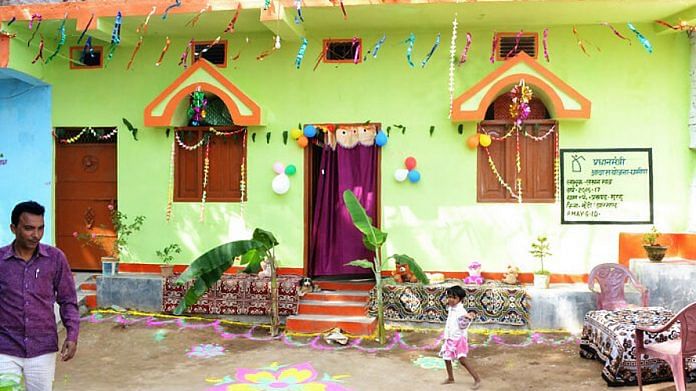The PM Awaas Yojana (Grameen) aims to provide ‘housing for all’ by 2022, with its immediate objective set at reaching 1 crore families by 2018-19.
New Delhi: The number of houses completed each year under the Centre’s flagship rural housing scheme, now called the Pradhan Mantri Awaas Yojana (Grameen), has nearly doubled since its overhaul two years ago.
The PMAY (G), introduced on 1 April 2016, is the reformed version of the Indira Awaas Yojana (IAY). It aims to provide “housing for all” by 2022, with its immediate objective set at reaching 1 crore families living in kutcha/dilapidated houses by 2018-19.
In 2017-18, around 38.67 lakh houses were built under the PMAY(G), and 32.22 lakh in 2016-17. Contrast this with the number of houses completed under the IAY in 2015-16, nearly half at 18.22 lakh. It was lower in the preceding financial years: 11.91 lakh in 2014-15, 10.51 lakh in 2013-14, and 10.49 lakh in 2012-13.
(The figures are for all the central rural housing schemes, but the proportion of those other than the IAY and PMAY is minuscule).
Renovating the IAY
According to officials in the union rural development ministry, problems in the IAY’s implementation had always been evident, but it was the comptroller of auditor general’s (CAG’s) scathing indictment in 2014 that spurred an earnest review.
Specifically, the CAG highlighted the lack of transparency in beneficiary selection under IAY. Other concerns raised included:
1) The absence of an effective monitoring process.
2) The quality of houses constructed.
3) The absence of convergence with other government welfare schemes.
4) The fact that designs for houses lacked diversity based on regional requirements. For eg. The house for a flood-prone area should be different from one in a desert.
“The idea was to re-structure the IAY in a way that would systematically address each of these concerns and make its implementation more effective,” said Amarjeet Sinha, secretary, rural development ministry.
An exhaustive verification process
Under the scheme, beneficiaries are entitled to a pucca house with basic amenities. The grant for each unit under the PMAY(G) has been increased from Rs 70,000 to Rs 1.20 lakh in the plains, and Rs 75,000 to Rs 1.30 lakh in the hilly states, difficult areas and Naxalism-hit districts.
The process of beneficiary selection has been a major area of focus for the overhaul. Selection is now done on the basis of socio economic and caste census (SECC) data, which includes detailed parameters of deprivation. An exhaustive verification process follows:
- Families that live in houses with kutcha walls or roofs are first identified.
- The list of beneficiaries is then made public in the respective gram sabhas, or village assemblies, after which objections and claims are entertained through an appellate process.
- Geo-tagging is the third filter. A picture of every beneficiary’s kutcha house has to be uploaded and geo-tagged by an official, who is then held responsible for any incorrect selection or misrepresentation.
According to the rural development ministry, they initially identified 4.3 crore prospective beneficiaries, of which 2.63 crore were eventually verified.
“I am 99.99 per cent sure that not one person with a pucca house would have been in the eligibility list for the PMAY(G). This is how fool-proof our beneficiary selection is,” Sinha said.
A home for Bharat
To address the issues around the quality and design of houses, the ministry has brought in different outlines in keeping with zone-specific requirements, climatic conditions etc. A house in Assam’s flood-prone areas, for instance, is supposed to be constructed on stilts.
According to ministry officials, there are more than 300 such designs, all vetted by the Central Building Research Institute.
Another major step has been the bid to encourage the PMAY (G)’s “convergence” with other government schemes, for example, providing assistance for the construction of toilets through the Swachh Bharat Mission, and LPG connections through Ujjwala, etc.
Keeping a close watch
However, according to ministry officials, what really sets the PMAY(G) apart from the IAY is the “effective monitoring process” instituted as part of the overhaul.
“We realised the rural housing programme wasn’t monitored with the intensity it needed and, hence, we decided to work out an end-to-end solution,” said rural development ministry secretary Sinha.
“The implementation guidelines were put together by the states, and we managed to remove the bottlenecks,” he added.
Essentially, the ministry relies on its online platform, AwaasSoft, to monitor the scheme in “real time”. Geo-tagged photos of the project at each stage — from a beneficiary’s existing house to the proposed site of the new construction as well as each subsequent step of progress — have to be uploaded on the website for the release of each instalment. The money is transferred directly to the beneficiary’s account. All the reports are available in the public domain.

As of now, 60 lakh houses are under construction; 47 lakh in “advanced stages of completion”. The ministry’s internal target is to complete 60 lakh houses by June this year, and the entire one crore by December, or March 2019 at the latest.
Building a poll strategy?
While the Centre may have indeed re-worked the scheme to show impressive completion numbers, the political significance of the initiative isn’t lost on anyone.
The scheme was launched by Prime Minister Narendra Modi in November 2016, and, given its populist nature, is bound to be key to the fortunes of the BJP in the 2019 Lok Sabha elections as well as the crucial state polls due later this year.
There is little doubt that welfare will be the main plank for the BJP in 2019, and rural housing a big part of that pitch.




Why God much bigger than God!!!!!!
Modi ji app great he or app God he
Mai na apply kiya tha lakin house ka koye list Mai nam nahi hai…… But I need to a house ….